Review: The mystery of an artist only deepens: The remarkable drawings of Martín Ramírez at DTLA’s new museum
- Share via
The graphic line in any great drawing by Martín Ramírez is so sure, so clear, so confidently composed as to make the elusive uncertainty of its subject matter profoundly strange. The friction between knowingness and not knowing ignites sparks.
In the marvelous Ramírez survey exhibition that inaugurates the Institute of Contemporary Art, Los Angeles, on a gritty downtown street across from the Greyhound bus station, trains enter tunnels to nowhere, disappearing into black holes. Fancy riders mounted on horseback pose within a theatrical proscenium, where human and animal both seem to grin.
Another horseback rider blows into a gigantic trumpet, its hugely swollen bell bigger than his prancing mount. Nearby, a crowned woman raises her hands in praise and benediction.
Just about everywhere, undulating linear patterns fan out, tying everything together. The patterns carry your eye across sheets of storm-tossed paper, made tactile by crumpling, flattening, layering and gluing. The rolling, curvilinear patterns are like ripples from a pebble dropped into a pond, or perhaps graphic signs for a sonic echo.
The artist’s presentation of conceptual mysteries through rigorous formal clarity is seductive. It’s as if Ramírez is determined to share something that he knows we may never grasp, no matter how hard we try. But we do want to try, caught up in the visual rhythms of drawing — a medium that is art’s most direct transcription of evolving thought.
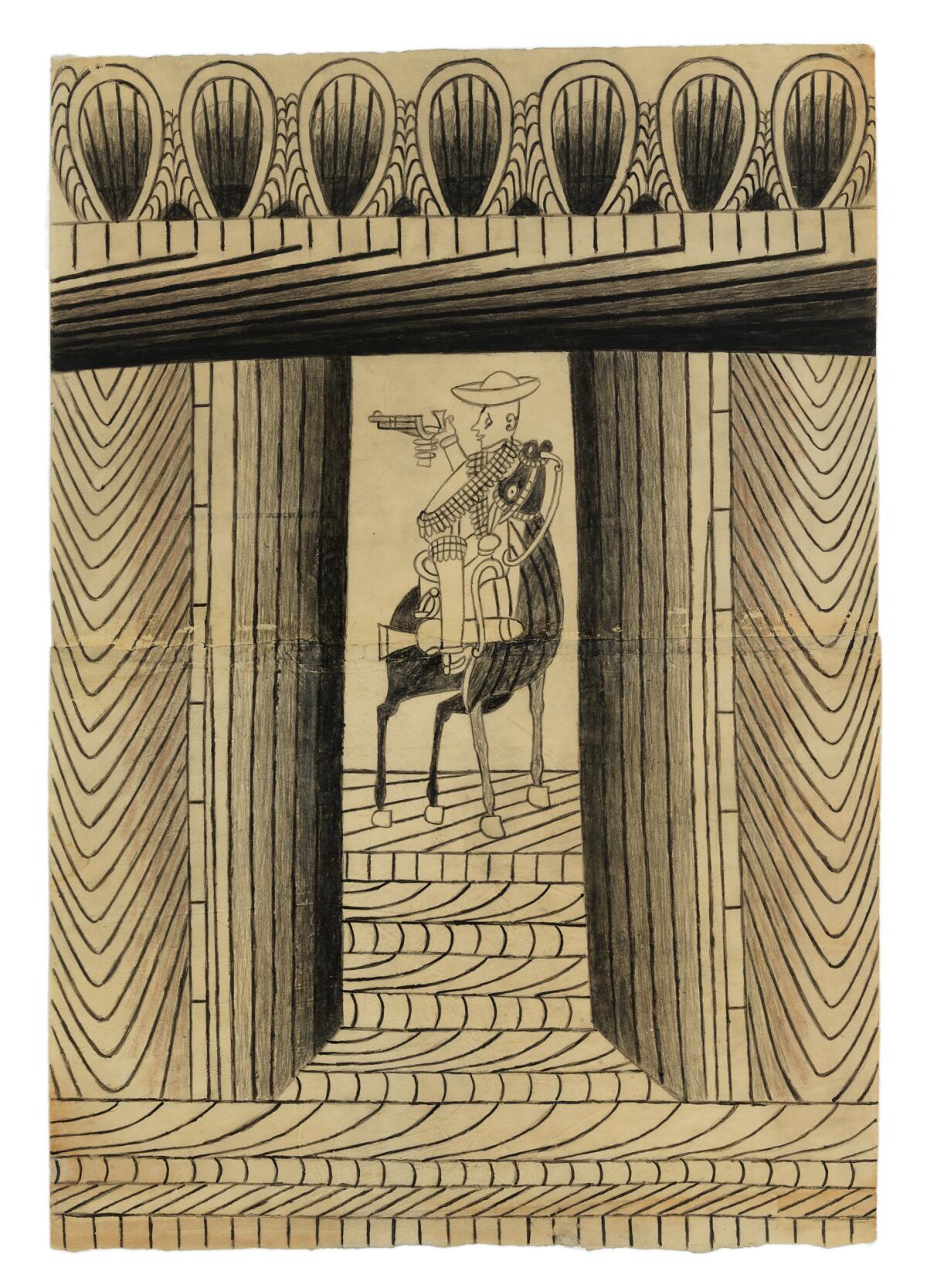
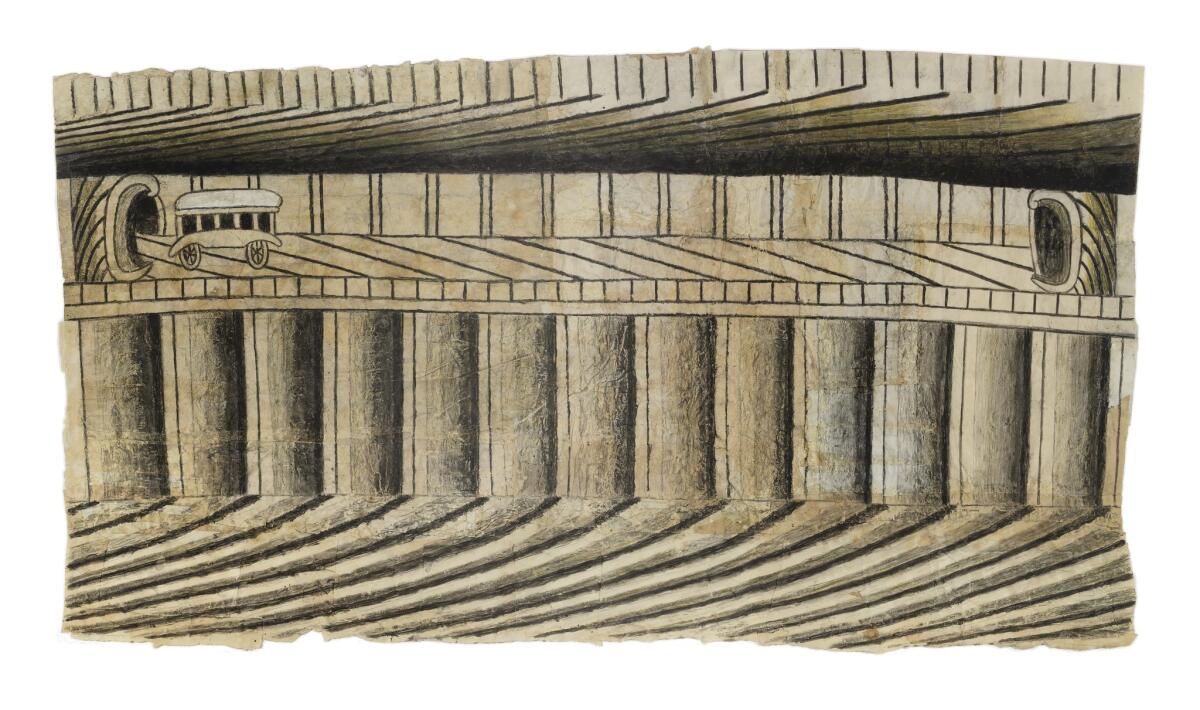
The show’s title, “Martín Ramírez: His Life in Pictures, Another Interpretation,” frankly declares that unraveling the celebrated self-taught artist’s work is not easy. Efforts have been underway since not long after his death in 1963; now, here comes “another interpretation.”
Elsa Longhauser, director of the ICA LA and curator for the show, organized an earlier one in Philadelphia in 1985, and the American Folk Art Museum in New York did a full retrospective in 2007. (With about 100 works, it was twice the size of the current survey.) This is the first monographic Ramírez exhibition to be seen in Southern California. A solid introduction, it is sure to rate among the most significant shows in the sprawling, Getty-subsidized Pacific Standard Time: LA/LA.
Ramírez was born in 1895 near Tepatitlán, Mexico, a small town in Jalisco about 45 miles east of Guadalajara. He left for the United States in 1925 in search of work, leaving behind a pregnant wife and three small children. He found mining jobs and worked as a railroad laborer in Northern California, but the devastating 1929 economic collapse sent him into a tailspin.
He never recovered. Jobless, homeless and picked up for vagrancy, Ramírez landed first in Stockton State Hospital, then DeWitt State Hospital near Sacramento.
During the Great Depression and after World War II, the cruel practice of using state hospitals as holding cells for vagrant immigrants was common in California. Despite attempts to escape, he was institutionalized for more than 30 years on flimsy diagnoses of mental incapacity, including schizophrenia.
Although he frequently added small drawings to letters he sent home, it may be that art therapy programs, a new twist in institutional treatment of psychological disorders, really got him going as an artist. (Victor M. Espinosa’s 2015 book, “Martin Ramírez: Framing His Life and Art,” is the most thorough accounting of his sketchy biography.) Whatever the case, almost all the more than 440 known drawings probably date from the 1950s to his death in 1963.
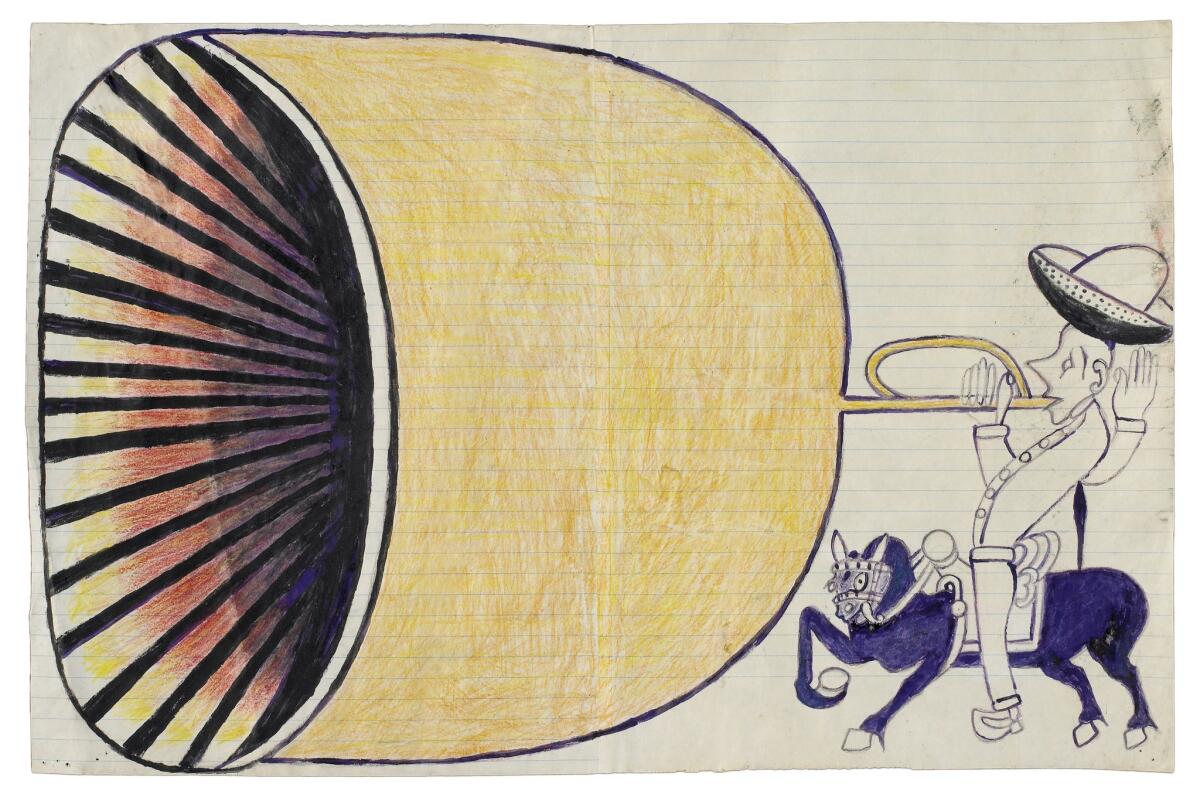
The show’s 51 examples are grouped thematically or stylistically. Among them is a monumental, 18-foot scroll, newly conserved, from the collection of noted Chicago Imagist artists Jim Nutt and Gladys Nilsson. (With 31 works, they are the show’s largest lender.) This is the first time the scroll has been shown. While not as unified or boldly drawn as other works, the scroll, pieced together from paper bags, notebook pages, newspapers and more, contains a virtual inventory of Ramírez’s motifs: wild animals, tunnels, trains, horses, public buildings, musicians, etc.
Ramírez, by all accounts deeply religious, only occasionally made his faith the obvious subject of these drawings. Clear examples are the so-called “Madonnas,” such as two of towering crowned women. One stands astride a serpent and a rosary; another is festooned with the elaborately decorated word “Reina” — Mary, Queen of Heaven.
In a third religious drawing, a figure of Christ hauls his shouldered cross, trudging before an impressive church facade. Perhaps the scene is a memory of an Easter procession witnessed during the artist’s Jalisco youth. This possible fusion of personal memory with orthodox Catholic iconography makes me wonder whether the many horse-and-rider drawings, stand-outs in the show, are more than simple recollections of his own life on a rural farm, which is how they are usually discussed.
Might they also meld the sacred with the secular?
Traditional designs from pottery and textiles are potential sources for his art’s images. The exhibition catalog also highlights pop culture cowboy pictures that may have caught Ramírez’s eye, perhaps in magazines, advertisements and commercial packaging.
ICA LA: New museum opens in downtown Los Angeles »
But the show’s most beautiful moment is a wall of eight caballero drawings — he made around 80 — all slightly different in composition yet, notably, not one showing the horse and rider in a natural landscape. Instead, they’re framed within patterned architectonic settings, as if posed on a stage or an altar platform. Could this unusual format partly be a recollection of devotional church icons of St. James, patron saint of Spain and laborers like himself?
The imposing figure of St. James — Santiago — on horseback was an influential propaganda tool in the history of Latin American conquest. Spain’s so-called “Moor killer” became a power emblem for Indian subjugation in New Spain, prominent in paintings and sculptures.
Ramírez was 30 when he left Jalisco, just as tensions were building there between the established authority of the Catholic Church, to which he was bound, and the new secular power of the post-revolutionary Mexican state. Within a year, skirmishes erupted into a violent uprising and the protracted, often bloody conflict called the Cristero War.
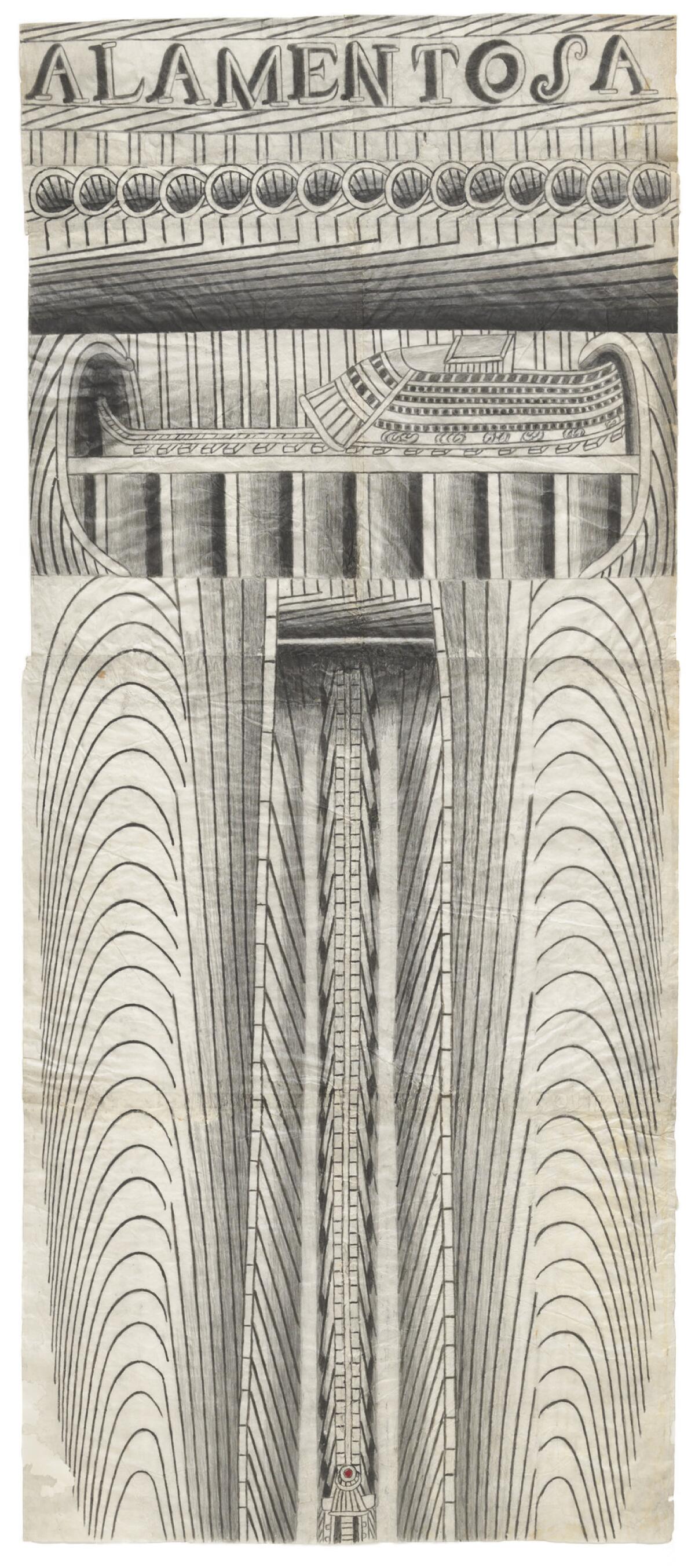
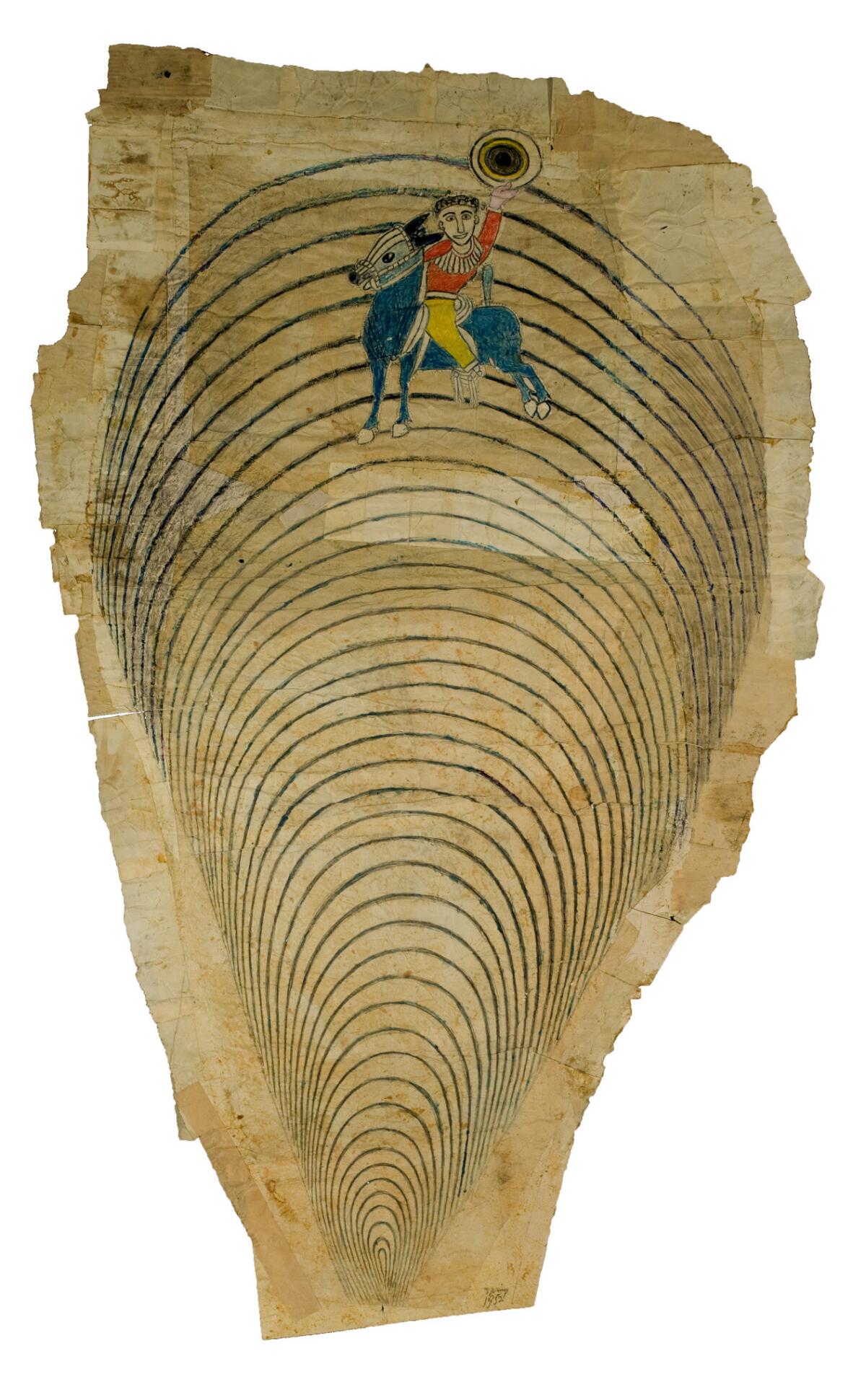
Does Ramírez’s horse and rider partly reflect Santiago? Is it a recollection of magazine ads for movie westerns or a farm produce label? A homemade childhood toy? A memory of personal experience in Tepatitlán?
There’s no way to know of course — and it could be all, none or more likely a combination of these. What matters is Ramirez’s inventiveness, which can take your breath away.
In a beautiful vertical drawing of a caballero astride a proud blue steed and wearing a bright red shirt and yellow pants, he waves his hat high over his head. Above, a semicircle of squashed paper medicine-cups, plentiful at the hospital, creates a subtle halo of stars. And below, a firmly drawn cascade of nested arcs visually lifts the rider up to the top of the sheet.
The curvilinear pattern is reminiscent of the ribbed shape of a scallop or cockle shell — the emblem of Santiago, which may very well be coincidental. Yet, pattern is repetition, and repetition is ritual. A deep sense of fierce devotion permeates Ramírez’s work, whatever the subject might be.
♦ ♦ ♦ ♦ ♦ ♦ ♦ ♦ ♦ ♦
‘Martín Ramírez: His Life in Pictures, Another Interpretation’
Where: ICA LA, 1717 E. 7th St., L.A.
When: Through Dec. 31; closed Mondays and Tuesdays
Info: (310) 284-8100, www.theicala.org
Twitter: @KnightLAT
MORE ART NEWS AND REVIEWS:
Power and prominence of Latino art: 'Anna Maria Maiolino' and 'Carlos Almaraz'
The godfather of Chicano art — and the son who's keeping his memory alive
How artist Camilo Ontiveros acquired the belongings of a DACA deportee
Did you spot the egg-shaped museum cruising L.A.? Next stop: LACMA
The biggest entertainment stories
Get our big stories about Hollywood, film, television, music, arts, culture and more right in your inbox as soon as they publish.
You may occasionally receive promotional content from the Los Angeles Times.








